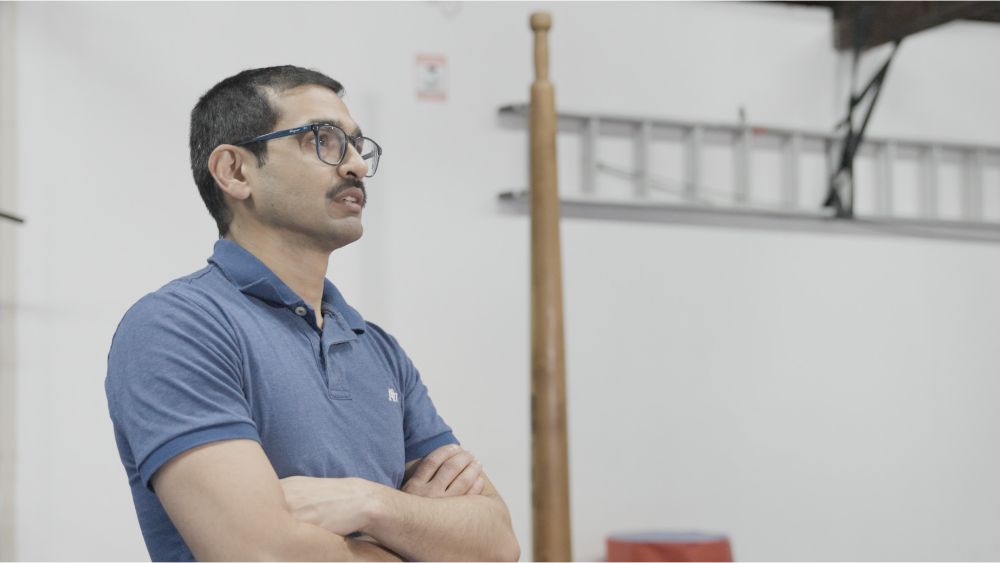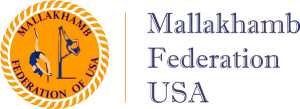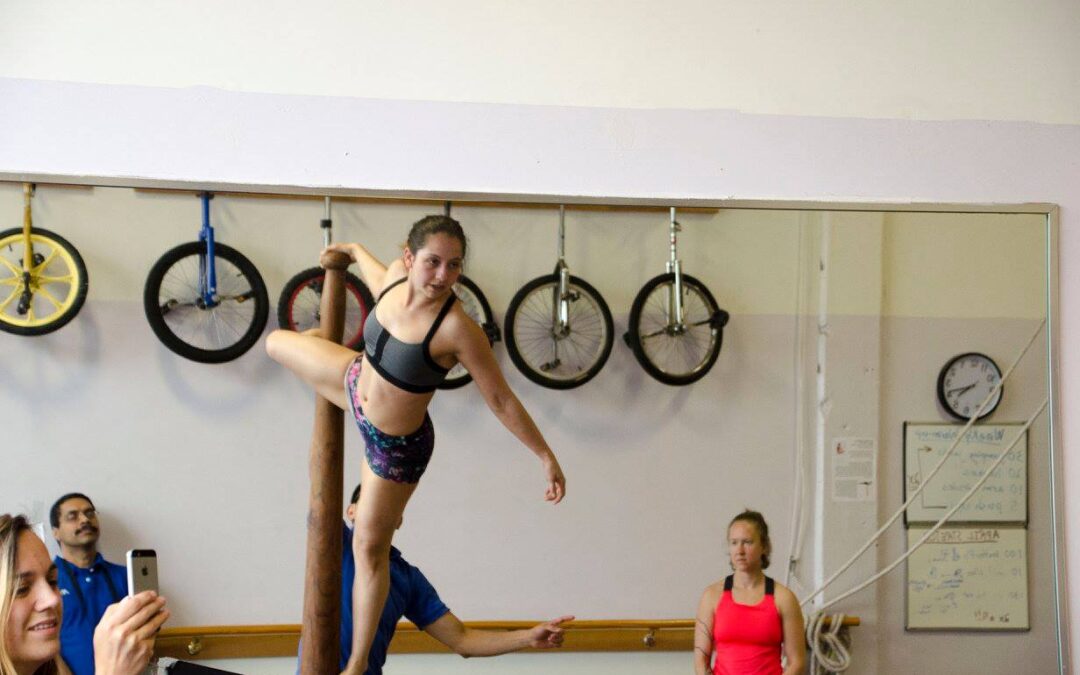Gymnasts don’t just stick to one type of exercise. Cross-training involves mixing different activities to improve overall performance. It’s like adding different ingredients to make a delicious dish – each element contributes to the final result. Therefore, Mallakhamb Cross-Training for Gymnasts is something you can consider.
So, why are we here? We are going to explore how Mallakhamb, an ancient sport, can be a good aid for gymnasts. Mallakhamb offers a unique blend of strength, balance, and agility training, making it a perfect complement to traditional gymnastics routines.
We’ll learn about the benefits of Mallakhamb as a cross-training tool for gymnasts and how it can take their skills to new heights. So, if you’re curious about this ancient art form and how it can revolutionize gymnastics cross-training, stick around!
Understanding Mallakhamb
Mallakhamb involves performing various exercises and poses on a wooden pole or a rope suspended from a ceiling. The wooden pole, typically made of teak or Sheesham wood, is around 2.6 meters in height and 20-25 centimeters in diameter. The rope Mallakhamb, on the other hand, consists of a cotton rope that is 1.5 to 2 meters in length and is hung from a height.
Mallakhamb techniques include climbing, swinging, balancing, and holding static poses. Practitioners utilize the pole or rope to execute intricate moves that require strength, flexibility, and body control.
The Benefits of Cross-Training in Gymnastics
Overall Fitness and Performance
- Engaging in cross training for gymnastics activities beyond traditional gymnastics routines prevents overuse injuries.
- Improves muscle balance and enhances athletic abilities.
- Introduces variety into training sessions of cross-training for gymnastics, keeping athletes motivated and engaged.
Improved Movement Patterns and Coordination
- Exposure to different movement patterns and challenges enhances coordination, proprioception, and spatial awareness.
Targeted Muscle Group Development
- Activities like Mallakhamb target specific muscle groups not adequately addressed through conventional methods alone.
- Mallakhamb improves core strength for Gymnastics, gives stability and upper body strength that is crucial for tumbling, vaulting, and apparatus work.
Improved Strength, Flexibility, and Endurance
Mallakhamb Cross-Training for Gymnasts leads to increased strength, flexibility, and endurance.
Mallakhamb’s dynamic exercises improve balance and body control, essential for executing precise gymnastics routines.
Mallakhamb Cross-Training Techniques for Gymnasts
Pole Mallakhamb
Surya Namaskar on the Pole
Performing a graceful sequence of yoga poses while balancing on the vertical pole not only looks impressive but also offers numerous benefits. This improves flexibility as you flow through different poses, strengthens your core muscles to maintain balance, and increases body awareness by challenging your coordination.
Dhanurasana (Bow Pose)
Lie face down on the pole, gripping it with your legs, and arch your back, lifting your chest and legs simultaneously. This pose particularly in Mallakhamb Cross-Training for Gymnasts is fantastic for strengthening the back, arms, and legs, as it engages multiple muscle groups to hold the position.
Chakrasana (Wheel Pose)
Starting by hanging upside down from the pole, gradually arch your back, creating a wheel-like shape. This pose is excellent for improving spinal flexibility and shoulder strength, as you stretch and open up your chest while supporting your body weight on the pole.
Rope Mallakhamb
Rope Climbing
Ascending and descending the thick rope attached to the pole is a classic exercise that targets grip strength, coordination, and endurance. As you pull yourself up using the rope, you engage your upper body muscles while also challenging your cardiovascular system.
Shirshasana (Headstand)
Performing a headstand while gripping the rope is a challenging yet rewarding pose when incorporating Mallakhamb cross-training for Gymnasts. This inversion pose not only enhances balance and concentration but also strengthens your upper body, particularly your shoulders, arms, and core muscles.
Naukasana (Boat Pose)
Sitting on the rope with your legs extended, lean back and lift your legs and torso off the ground. This Mallakhamb exercise for Gymnastics is an excellent way to engage your core and hip flexors, as you work to maintain balance and stability on the rope.
Hanging Mallakhamb
Pull-Ups and Leg Raises
Hanging from the horizontal bar, perform pull-ups to strengthen your upper body muscles, particularly your back and arms. Adding leg raises to the movement targets your lower abs, providing a comprehensive core workout.
Front Lever
Hanging horizontally, parallel to the ground, gripping the bar challenges your back, shoulders, and core muscles. As core-muscles are involved, this Mallakhamb cross-training technique for Gymnasts is considered a good one. Maintaining this position strengthens these muscle groups, helping you develop greater overall strength and stability.
Skin the Cat
Swinging forward, passing your legs through your arms, and rotating around the bar is a dynamic movement that improves shoulder mobility and grip strength. This exercise also enhances body control and coordination as you transition through the movements.
Rope & Pole Mallakhamb
Combination Poses
Combining pole and rope techniques from Mallakhamb cross-training for Gymnasts allows for seamless transitions between different poses, challenging your body in new and exciting ways. By integrating both elements, you can create fluid sequences that enhance your agility and coordination.
Dynamic Movements
Swinging between the pole and rope while incorporating spins, twists, and flips adds an extra layer of complexity to your Mallakhamb practice. These dynamic movements not only improve coordination and agility but also provide a fun and challenging way to push your limits and explore new possibilities in your training.
Mallakhamb’s Cross-Training for Gymnastics Impact on Gymnasts Skills
- Strength Benefits
- Builds upper body, core, and grip strength.
- Engages multiple muscle groups for functional gains.
- Improving gymnastics performance.
- Flexibility and Balance
- Improves flexibility and balance crucial for cross-training for gymnastics.
- Increases range of motion and joint flexibility.
- Enhances overall balance and proprioception.
- Core Stability and Control
- Challenges core muscles for stability during dynamic movements.
- Improves core strength and stability.
- Enhances body control and coordination for precise execution.
Incorporating Mallakhamb into Gymnastics Training Programs
Tips for Integrating Mallakhamb into Gymnastics Routines
- If you’re new to Mallakhamb, begin with basic exercises and gradually progress to more advanced poses. This allows your body to adapt to the new movements and build strength gradually.
- Incorporate Mallakhamb Cross-Training for Gymnasts into your existing gymnastics routines by alternating Mallakhamb sessions with traditional training. This adds variety to your workouts and keeps things interesting.
- Pay attention to proper form and technique when practicing Mallakhamb Training to prevent injuries and maximize benefits. Seek guidance from experienced instructors to ensure you’re performing exercises correctly.
- Consistency is key to seeing results. Aim to incorporate Mallakhamb into your training program regularly to reap the full benefits.
Sample Mallakhamb Cross-Training Schedules for Gymnasts
Here’s a sample cross-training schedule that integrates Mallakhamb into a gymnast’s weekly routine:
- Monday: cross training for gymnastics practice focusing on skills and routines
- Tuesday: Mallakhamb session emphasizing strength and flexibility
- Wednesday: Rest day or light cardio workout
- Thursday: gymnastics cross training practice with a focus on conditioning and drills
- Friday: Mallakhamb session focusing on balance and coordination
- Saturday: gymnastics cross training practice with a focus on performance and routine refinement
- Sunday: Rest day or active recovery session
Feel free to adjust the schedule based on your individual training needs and preferences.
Safety Considerations and Precautions When incorporating Mallakhamb Cross-Training for Gymnasts
- Warm-Up Properly
Always start your Mallakhamb Training or gymnastics sessions with a thorough warm-up to prepare your muscles and joints for exercise.
- Use Proper Equipment
Ensure that the Mallakhamb apparatus is sturdy and well-maintained to prevent accidents or injuries.
- Listen to Your Body
Pay attention to any signs of discomfort or pain during training and stop immediately if you experience any issues. Consult a coach or healthcare professional if necessary.
- Progress Gradually
Don’t rush into advanced exercises or poses before mastering the basics. Take your time to build strength and confidence gradually to avoid injuries.
Conclusion
Mallakhamb offers numerous benefits as a cross-training tool for gymnasts. By integrating Mallakhamb cross-training for Gymnasts into their training programs, athletes can improve strength, flexibility, balance, and coordination, ultimately enhancing their overall performance.
We encourage gymnasts to explore new training methods like Mallakhamb Training to diversify their workouts and challenge themselves in new ways. With proper guidance and consistency, Mallakhamb has the potential to take gymnastics cross training performance to new heights.
So, whether you’re a beginner or an experienced gymnast, consider adding Mallakhamb to your training routine and experience the transformative benefits for yourself!
FAQs
1. What unique muscle groups does Mallakhamb target compared to traditional gymnastics?
Mallakhamb focuses on grip strength, forearms, and shoulder stabilizers, crucial for gymnastics but often overlooked in conventional training.
2. How does Mallakhamb enhance gymnasts’ proprioception and spatial awareness?
Mallakhamb’s dynamic movements constantly challenge body positioning and balance, improving gymnasts’ spatial awareness and proprioception.
3. Can Mallakhamb break through training plateaus and improve specific gymnastics skills?
Yes, by introducing novel challenges, Mallakhamb can overcome plateaus and enhance skills like tumbling or apparatus work.
4. What advanced Mallakhamb techniques can elite gymnasts use for a competitive edge?
Techniques like transitions between pole and rope or high-speed spins offer elite gymnasts unique challenges for skill refinement.
5. How does Mallakhamb integrate with gymnastics training periods to optimize performance and prevent overtraining?
Strategically integrating Mallakhamb into training phases targets specific goals while allowing for recovery, reducing overtraining risk.


